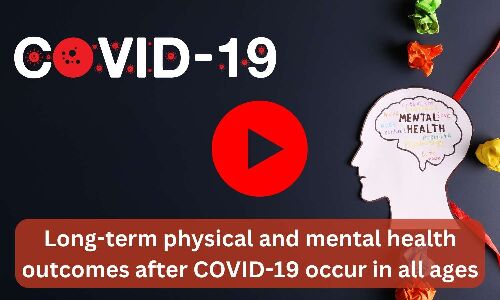
Studies have established
that some people infected with COVID-19 suffer long-term health problems
following the acute phase of the disease. However, evidence on post-acute (post-COVID-19)
syndrome is still limited, especially for children and adolescents.
Following COVID-19
infection, there is significant new onset morbidity in children, adolescents
and adults across 13 distinct diagnosis and symptom complexes, according to a new
study publishing November 10th in the open access journal PLOS Medicine by
Martin Roessler of Technische Universität Dresden, Germany, and colleagues.
In the new study, using a
healthcare dataset covering nearly half the German population and spanning all
of 2019 and 2020, researchers identified patients with a polymerase chain
reaction (PCR)-confirmed diagnosis of COVID-19. They then compared the
occurrence of pre-specified diagnoses, entered into the medical record at least
three months post-infection, in these patients (11,950 children and adolescent
and 145,184 adults) to a control cohort of more than 750,000 individuals with
matched age, sex and pre-existing medical conditions, without PCR-confirmed
COVID-19.
Overall, children and
adolescents who had been infected with COVID-19 were 30% more likely than
controls to have documented health problems beginning three months or more
after infection (436.91 vs 335.98 per 1,000 person-years, IRR=1.30, 95%
CI=1.25-1.35, p<0.01). Adults with COVID-19 were 33% more likely than
controls to have health problems (615.82 vs 464.15 per 1,000 person-years,
IRR=1.33, 95% CI=1.31-1.34, p<0.01). Among children and adolescents, rates
of malaise/fatigue/exhaustion, cough and throat/chest pain were the most
strongly associated with a prior COVID-19 infection, but rates of headache,
fever, abdominal pain, anxiety disorder and depression were also increased.
Among adults, smell/taste disturbance, fever, and dyspnea (or difficulty
breathing) were most strongly associated with COVID-19 infection but also more
common were cough, throat and chest pain, hair loss, fatigue, exhaustion and
headache.
“The results of the present
study indicate that post-COVID-19 syndrome cannot be dismissed among children
and adolescents,” the authors say. “We found that COVID-19 diagnosis was
associated with higher long-term demand for healthcare services as reflected in
outpatient and inpatient diagnoses of a broad set of outcomes more than three
months after confirmed SARS-CoV-2 infection. While children and adolescents
appear to be less affected than adults, these findings are statistically
significant for all age groups.”
Roessler adds, “The results
of our study indicate that people of all age groups, including children and
adolescents, are at risk of post-COVID-19 syndrome.”
Reference:
Roessler M, Tesch F, Batram
M, Jacob J, Loser F, Weidinger O, et al. (2022) Post-COVID-19-associated
morbidity in children, adolescents, and adults: A matched cohort study
including more than 157,000 individuals with COVID-19 in Germany. PLoS Med
19(11): e1004122. https://doi.org/10.1371/journal.pmed.1004122
